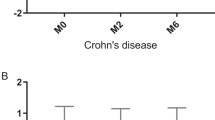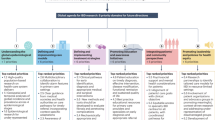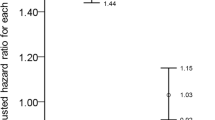Abstract
Background
The aim of this study was to assess PA patterns among children and adolescents with inflammatory bowel disease (IBD).
Methods
Sixty participants with IBD (42 Crohn’s disease [CD], 10 ulcerative colitis [UC], and 8 IBD—unclassified [IBD-U], 30 male patients) in remission (n = 45) or with mild disease (n = 15) were compared with 60 healthy age- and sex-matched controls. Each participant wore a triaxial accelerometer during 4 consecutive days for objective daily PA quantification.
Results
Overall, there was no significant difference in daily PA patterns between patients with IBD and healthy controls, with 31.7% of patients with IBD and 38.3% of healthy controls fulfilling the recommendation of 60 min of moderate-to-vigorous physical activity (MVPA) daily (NS). Male patients with IBD spent significantly less time in MVPA compared with matched healthy controls (mean difference, 16.2 min day−1; p < 0.05). No difference was observed for female patients with IBD. No difference in sedentary pattern between male patients with IBD and controls was found.
Conclusions
Children and adolescents with inactive or mildly active IBD have similar PA patterns compared with healthy controls, except for male patients who have reduced moderate-to-vigorous PA. By far, most patients with IBD do not fulfill the MVPA recommendations for health benefits.
Impact
-
There is few data on PA patterns in pediatric patients with IBD.
-
Methodological issues to assess PA limit the strengths of these studies.
-
Pediatric IBD patients with inactive or mildly active IBD have similar physical activity patterns compared with healthy controls, except for male patients who have reduced moderate-to-vigorous PA.
-
Most patients with IBD do not fulfill the MVPA recommendations for health benefits.
Similar content being viewed by others
Log in or create a free account to read this content
Gain free access to this article, as well as selected content from this journal and more on nature.com
or
References
Ghione, S. et al. Dramatic increase in incidence of ulcerative colitis and Crohn’s disease (1988-2011): a population-based study of French adolescents. Am. J. Gastroenterol. 113, 265–272 (2018).
Ng, S. C. et al. Worldwide incidence and prevalence of inflammatory bowel disease in the 21st century: a systematic review of population-based studies. Lancet 390, 2769–2778 (2018).
Caspersen, C. J., Powell, K. E. & Christenson, G. M. Physical activity, exercise, and physical fitness: definitions and distinctions for health-related research. Public. Health Rep. 100, 126–131 (1985).
Pedersen, B. K. & Saltin, B. Exercise as medicine - evidence for prescribing exercise as therapy in 26 different chronic diseases. Scand. J. Med. Sci. Sports 25, 1–72 (2015).
U.S. Department of Health and Human Services. Physical Activity Guidelines for Americans 2nd edn (U.S. Department of Health and Human Services, Washington, DC, 2018).
Cale, L. & Harris, J. Exercise recommendations for young people: an update. Health Educ. J. 101, 126–138 (2001).
Saunders, T. J. & Vallance, J. K. Screen time and health indicators among children and youth: current evidence, limitations and future directions. Appl. Health Econ. Health Policy 15, 323e31 (2017).
Sawczenko, A. & Sandhu, B. Presenting features of inflammatory bowel disease in Great Britain and Ireland. Arch. Dis. Child. 88, 995–1000 (2003).
Narula, N. & Fedorak, R. N. Exercise and inflammatory bowel disease. Can. J. Gastroenterol. 22, 497–504 (2008).
Bourdier, P. et al. Physical activity and sedentary levels in children with juvenile idiopathic arthritis and inflammatory bowel disease. A systematic review and meta-analysis. Pediatr. Res. 86, 149–156 (2019).
Mählmann, L. et al. Psychological wellbeing and physical activity in children and adolescents with inflammatory bowel disease compared to healthy controls. BMC Gastroenterol. 17, 160 (2017).
Walker, R. G. et al. Sedentary time and screen-based sedentary behaviors of children with a chronic disease. Pediatr. Exerc. Sci. 27, 219–225 (2015).
Werkstetter, K. J. et al. Lean body mass, physical activity and quality of life in paediatric patients with inflammatory bowel disease and in healthy controls. J. Crohns Colitis 6, 665–673 (2012).
Vanhelst, J., Béghin, L., Drumez, E., Coopman, S. & Gottrand, F. Awareness of wearing an accelerometer does not affect physical activity in youth. BMC Med. Res. Methodol. 17, 99 (2017).
Vanhelst, J. et al. Physical activity is associated with improved bone health in children with inflammatory bowel disease. Clin. Nutr. 39, 1793–1798 (2020).
Gower-Rousseau, C. et al. Incidence of inflammatory bowel disease in northern France (1988-1990). Gut 35, 1433–1438 (1994).
Hyams, J. S. et al. Development and validation of a pediatric Crohn’s disease activity index. J. Pediatr. Gastroenterol. Nutr. 12, 439–447 (1991).
Turner, D. et al. Development, validation, and evaluation of a pediatric ulcerative colitis activity index: a prospective multicenter study. Gastroenterology 133, 423–432 (2007).
Vanhelst, J. Quantification de l’activité physique par l’accélérométrie [Physical activity assessment using accelerometry]. Rev. Epidémiol. Publique 67, 126–134 (2019).
Rich, C. et al. Quality control methods in accelerometer data processing: defining minimum wear time. PLoS ONE 8, e67206 (2013).
Romanzini, M., Petroski, E. L., Ohara, D., Dourado, A. C. & Reichert, F. F. Calibration of ActiGraph GT3X, actical and RT3 accelerometers in adolescents. Eur. J. Sport Sci. 14, 91e9 (2014).
Ottevaere, C. et al. The use of accelerometry in adolescents and its implementation with non-wear time activity diaries in free-living conditions. J. Sports Sci. 29, 103–113 (2011).
Ridley, K., Ainsworth, B. E. & Olds, T. S. Development of a compendium of energy expenditures for youth. Int. J. Behav. Nutr. Phys. Act. 10, 45 (2008).
Baquet, G., Stratton, G., Van Praagh, E. & Berthoin, S. Improving physical activity assessment in prepubertal children with high-frequency accelerometry monitoring: a methodological issue. Prev. Med. 44, 143–147 (2007).
Dorn, D. et al. Automatic identification of physical activity type and duration by wearable activity trackers: a validation study. JMIR Mhealth Uhealth 7, e13547 (2019).
Renninger, M. et al. Associations between accelerometry measured physical activity and sedentary time and the metabolic syndrome: a meta-analysis of more than 6000 children and adolescents. Pediatr. Obes. 15, e12578 (2020).
Ekelund, U. et al. Dose-response associations between accelerometry measured physical activity and sedentary time and all cause mortality: systematic review and harmonised meta-analysis. BMJ 366, l4570 (2019).
Ruiz, J. R. et al. Objectively measured physical activity and sedentary time in European adolescents: the HELENA study. Am. J. Epidemiol. 174, 173–184 (2011).
Sallis, J. F., Prochaska, J. J. & Taylor, W. C. A review of correlates of physical activity of children and adolescents. Med. Sci. Sports Exerc. 32, 963e75 (2000).
Dumith, S. C., Gigante, D. P., Domingues, M. R. & Kohl, H. W. Physical activity change during adolescence: a systematic review and a pooled analysis. Int. J. Epidemiol. 40, 685e98 (2011).
Matthews, C. E. et al. Amount of time spent in sedentary behaviors in the United States, 2003e2004. Am. J. Epidemiol. 167, 875–881 (2008).
Ortega, F. B. et al. Objectively measured physical activity and sedentary time during childhood, adolescence and young adulthood: a cohort study. PLoS ONE 8, e60871 (2013).
Béghin, L. et al. Influence of meteorological conditions on physical activity in adolescents. J. Epidemiol. Community Health 74, 395–400 (2020).
Beets, M. W., Vogel, R., Forlaw, L., Pitetti, K. H. & Cardinal, B. J. Social support and youth physical activity: the role of provider and type. Am. J. Health Behav. 30, 278–289 (2006).
Acknowledgements
The authors thank the participants for enrolling in the study. There is no funding to support this study.
Author information
Authors and Affiliations
Contributions
Each author of this article significantly contributed to the study, especially J.V., L.B., D.L., F.G., S.C. and D.T. designed research; J.V., L.B., and S.C. conducted research; J.V. and J.L. analyzed the data; J.V., F.G., and D.T. wrote the paper; J.L. analyzed the data and performed statistical analysis; J.V. had primary responsibility for final content. All authors read and approved the final manuscript.
Corresponding author
Ethics declarations
Competing interests
The authors declare no competing interests.
Consent statement
Before beginning the study, its objectives were carefully explained to each participant and their parents/guardian. Written informed assent was obtained from the participant and consent from the parents (or guardian) by the study physician.
Additional information
Publisher’s note Springer Nature remains neutral with regard to jurisdictional claims in published maps and institutional affiliations.
Rights and permissions
About this article
Cite this article
Vanhelst, J., Béghin, L., Turck, D. et al. Daily physical activity patterns in children and adolescents with inflammatory bowel disease. Pediatr Res 90, 847–852 (2021). https://doi.org/10.1038/s41390-020-01313-5
Received:
Revised:
Accepted:
Published:
Issue date:
DOI: https://doi.org/10.1038/s41390-020-01313-5



